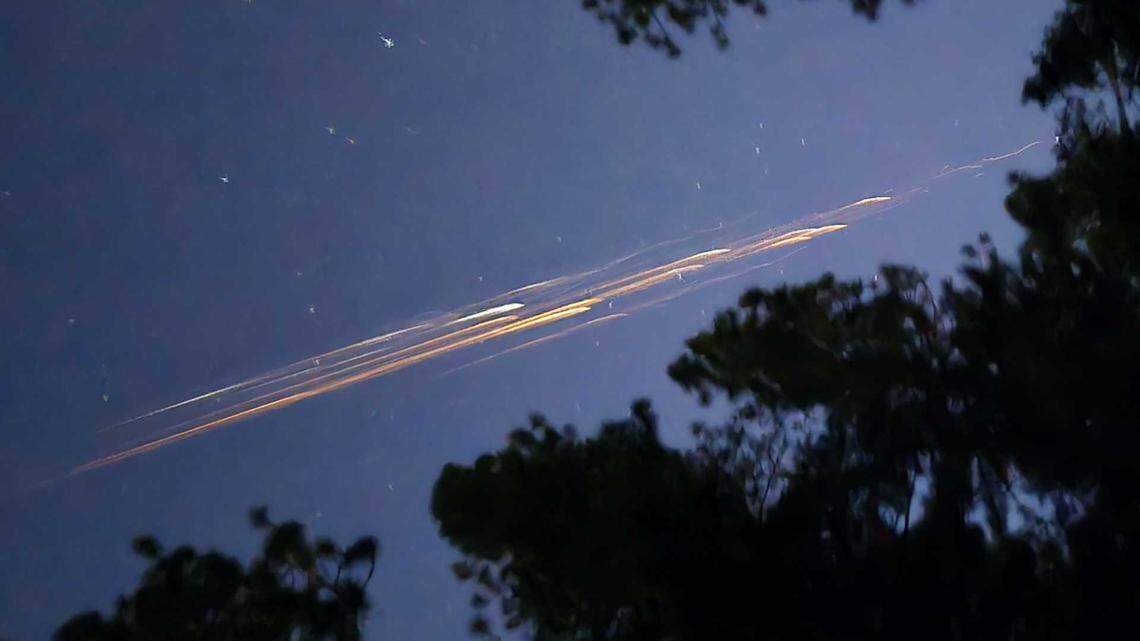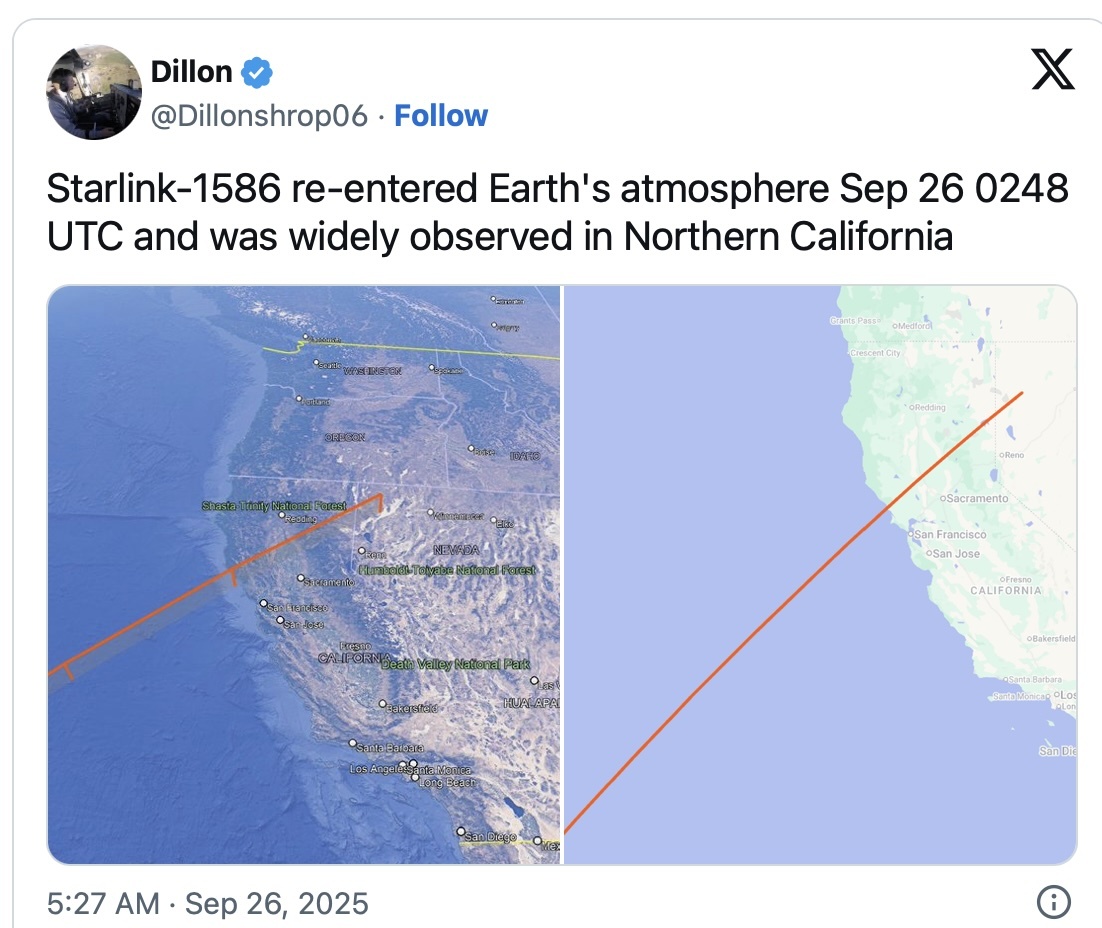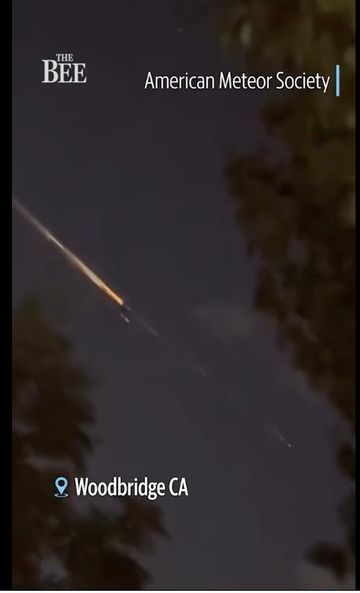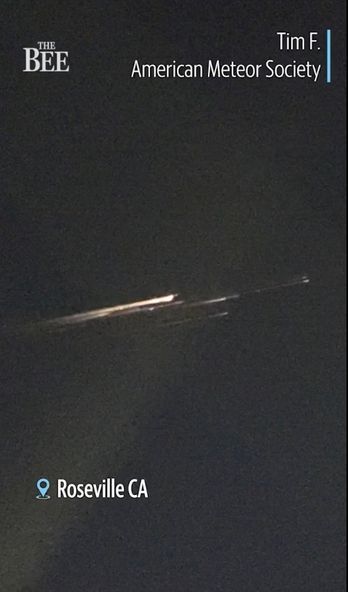27.09.2025
Fireball breaks up in skies over Northern California. Here’s what it was

A SpaceX Starlink satellite lights up the sky Sept. 26, 2025 over the Sacramento area and Northern California as it re-enters Earth's atmosphere. By David Caraccio
A fiery streak of space debris lit up the Northern California sky Thursday night, drawing hundreds of reports from residents across the Sacramento area, the Bay Area and beyond. The American Meteor Society received more than 200 eyewitness reports of the glowing object, which was visible around 7:50 p.m. In the capital region, residents in Citrus Heights, Roseville and Vacaville captured videos showing a white-and-orange fireball breaking apart as it moved from west to east across the sky. Sightings were reported as far south as the Los Angeles area. Amateur astronomers identified the object as Starlink-1586, a SpaceX satellite launched in 2020 from Florida. The satellite re-entered Earth’s atmosphere around 7:48 p.m. Pacific time, traveling at an estimated 17,500 mph, according to satellite tracking by the Aerospace Corp. Starlink is SpaceX’s satellite internet constellation, designed to provide global high-speed broadband coverage, particularly in rural or underserved areas. The system operates in low Earth orbit, where thousands of small satellites form a network to transmit internet signals to users on the ground. Officials from NORAD, U.S. Space Force and SpaceX, which launched the satellite, did not immediately respond to requests for comment Friday. A brief FAA advisory noted the controlled re-entry, which posed no threat to the public.

The re-entry happened about two hours before the launch of another satellite, Starlink-1711 aboard a Falcon 9 rocket, at Vandenburg Air Force Base in Santa Barbara County. Aerospace Corp., which monitors orbital re-entries, noted that human-made space debris can often be mistaken for meteors but tends to move more slowly and break into multiple parts. “If there appear to be a tight cluster of bright points all moving in the same direction at similar speeds, and all leaving streaks behind them, then it is very probably a reentry breakup,” the group said on its website about object re-entries. “If the object is moving extremely fast, and the event is gone in a flash or a few seconds, then it is very probably a meteor.”


In videos shared to the meteor society and to local TV outlets, the satellite’s breakup appeared dramatic but serene, moving slowly across the sky and trailing glowing fragments for several seconds. As of Friday morning, no reports of damage or debris on the ground had been confirmed.
Quelle: The Modeste Bee
+++
Space debris from Starlink re-entry spotted in sky above Saskatoon
Astronomy professor asks people to keep an eye out for space debris
Cody Koloski had his eyes on the sky Monday night, hoping to see the northern lights dancing above Saskatoon.
The aurora borealis show started picking up near midnight, but then it was interrupted. Something unnatural appeared in the sky. Koloski looked west and saw a bright light moving toward him.
"I'm like, 'Huh, interesting, kind of strange but cool,' and then I keep looking at it and it's getting bigger and brighter," Koloski said. "I had a moment of like, 'Oh no, is this like a little prelude to something bigger? Are we going to get struck by these meteors or something?' So, a brief panic."
hen the bright light seemed to split apart into pieces that started to spin as they streaked across the sky, leaving a trail of what looked like orange embers in their wake.
As fast as it began, it was over. The lights fizzled out as they moved eastward.
Koloski had never seen anything like it before.
"The video honestly doesn't do it justice. It felt as though I could almost reach up and touch it. That's how close it was."
His friend Justin Tan captured the last bit of the strange spectacle on his phone and sent the video to Koloski. He posted it online in the Saskatoon forum on Reddit, and people started musing about what it could be. Other Reddit users who witnessed the event in Saskatoon, and in Calgary, also shared it online.
Lights were Starlink satellite falling back to earth
What Koloski witnessed was actually space debris from a SpaceX Starlink satellite re-entry, said Samantha Lawler, a professor of astronomy at the University of Regina. She's interested in how satellites are changing the night sky.
Lawler said Starlink currently has more than 8,000 satellites, which are about the size of a Ford F-150, in orbit. Researchers believe the one that burned up above the prairies in the wee hours of Tuesday morning was Starlink #1,066.
Starlink satellites have a lifespan of just five years, so when they've reached their end of life, they fall back down to Earth, burning up in our atmosphere, leaving behind metals — and it's unclear what those long-term effects will be.
They don't always burn up completely.
In 2024, Saskatchewan farmer Barry Sawchuk found a big chunk of space debris on his land near Ituna, just west of Yorkton, that turned out to be part of a Space X rocket.
Then a panel the size of a laptop computer was discovered on a farm about 15 kilometres southeast of Hodgeville, Sask.
Now, scientists are trying to zero in on where pieces of Starlink #1,066 may have ended up if they did hit the ground.
Lawler is asking Saskatchewan residents to keep their eyes peeled for any evidence of space debris. She said the Canadian Space Agency advises people to contact the RCMP if they spot something, but she would also love to be notified to assist with her research.
"This is really useful information for learning about the disposability practices of megaconstellations," Lawler said.
Megaconstellation is the term for a group of satellites working together to deliver broadband internet access.
Lawler also encouraged others to keep sharing videos when they capture something strange happening in the sky, because it helps scientists triangulate how the debris moved across the sky and where it might have landed.
She said it could become a more common appearance to spot a satelitte re-entry in Saskatchewan, because of Starlink's orbit. The pathway means they spend more time over the province, so they are more likely to burn up while overhead.
"Don't worry about getting hit by space debris. This is not something that individuals really need to worry about, but as a society — is this really how we want to be using our orbit? We''re just throwing things away, burning them up in the atmosphere, dropping them on the ground. It's like billionaires dropping their garbage on our head."
Lawler acknowledged satellites are important, but said there are better ways to use them.
"We can try to prioritize making satellites last longer. We can try to prioritize using fewer satellites to deliver services. We can use different altitude orbits," she said. "There's a lot of different options here but SpaceX has gotten there first and they're kind of setting the tone."
Quelle: CBC


